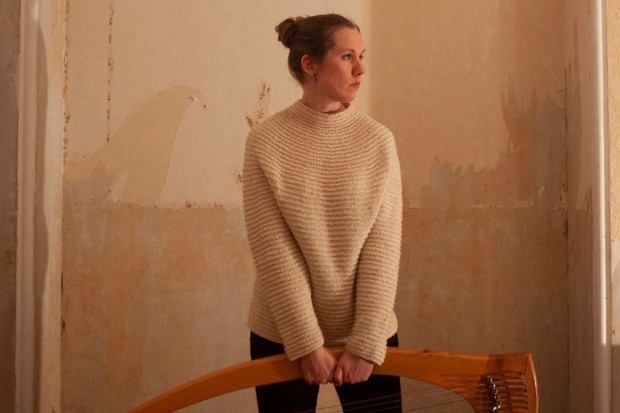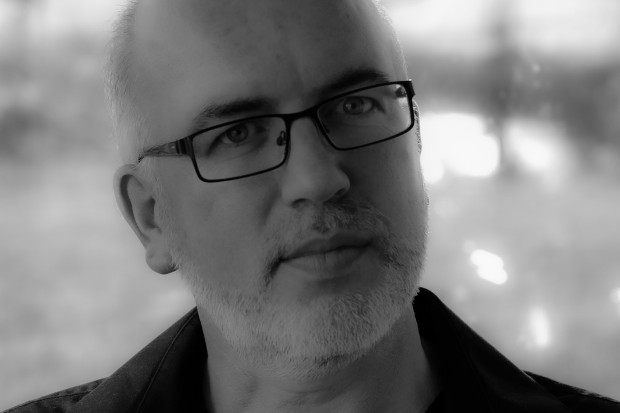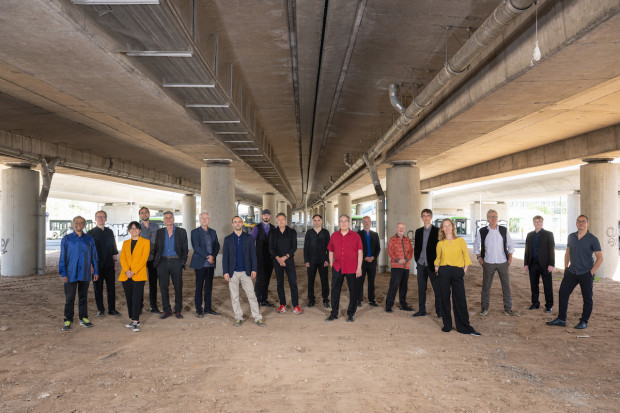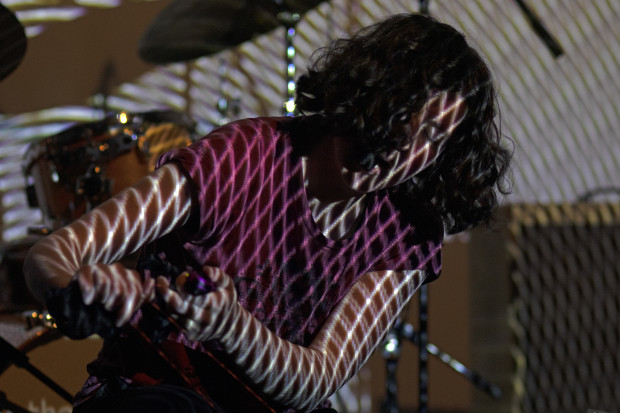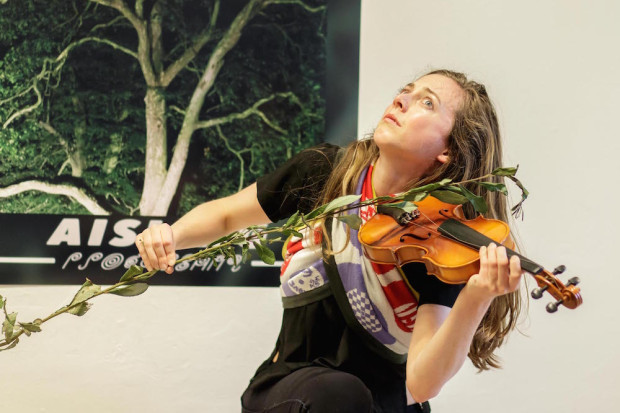
Composer and vocalist Laura Bowler being tattooed live on stage during her work 'ADVERT' at Huddersfield Contemporary Music Festival (Photo: Point of View Photography)
A Northern Star: What Ireland Can Learn from Huddersfield
While Irish composers generally get short shrift in their own country, they continue to make waves on the international circuit. Last weekend, the 46th edition of the Huddersfield Contemporary Music Festival (stylised as hcmf//) got underway with Jennifer Walshe installed as composer-in-residence. The festival is now in the second year of a three-year partnership with Culture Ireland aiming to bring the work of Irish composers on to the world stage. Walshe’s work PERSONHOOD (2021) opened the festival while the opening weekend also featured pieces by Irene Murphy, Ann Cleare and Natalia Beylis, with Kirkos, Karen Power, Tonnta and Stone Drawn Circles scheduled to feature later in the festival.
This review focuses on the first three days in what proved to be a lively weekend in the northern town.
Day 1 – Friday 17 November
PERSONHOOD
Although PERSONHOOD was already reviewed by this journal on its Irish premiere by the Oslo Sinfonietta and Andreas Borregaard at the 2022 edition of New Music Dublin, it is interesting to observe how second performances can refine one’s perception. The piece included elements of music theatre, multimedia and dance choreography forcing Borregaard into a series of experimental transformations initiated by sharp stylistic changes in the music.
Back in May 2022 it seemed to me that the main focus of the piece was how the concept of personal identity had been eroded in our contemporary digital landscape. This is certainly a central theme but a second hearing really brought home the extent to which such control and enslavement are refracted through the human body. Borregaard may be an accordionist, but it is his body that does most of the performing whether it be writhing as Britney Spears (is there any pop star whose body has been more analysed?), mirroring the exercise routines of CEOs or gulping down vitamin potions prepared during the performance by percussionist Håkon Stene. A montage of 1950s footage of institutionalised control over the physical body underlined this message. Although there were many moments of humour, these tended to accentuate the disturbing undercurrents lurking beneath the work’s surface.
Stand-by for Minna
In tandem with the festival’s Irish focus, hcmf also placed the spotlight on Lithuanian music and the first concert in this strand featured a world premiere from composer and sound artist Arturas Bumšteinas. Entitled Stand-by for Minna, the piece was inspired by the twentieth-century British composer Minna Keal who had studied composition in her teenage years but was later forced to give it up due to family commitments only to resume writing music in her 80s. While foraging for material, Bumšteinas’ interest in Keal was piqued when he came across a documentary on the composer in the British Library.
The piece was based on extracts from Keal’s Wind Quintet, op. 2, which were looped into a drone texture performed by two organists (Benus Jonušas and Gailė Griciūtė). It evolved slowly but ended up in quite a different place from where it began with the beating produced by gentle dissonances in the middle and low registers making for a pleasant listening experience.

Gailė Griciūtė performing in Stand-by for Minna (Photo: Point of View Photography)
Day 2 – Saturday 18 November 2023
Exhibition: At the first Sound, the Whole World Freezes
As well as having several pieces in the festival, Huddersfield Art Gallery gave over its space to an exhibition by Walshe that covered the vast and eclectic range of interests that make up her world. From inflatable saxophones and toy soldiers to her interest in various bizarre subcultures, the exhibition gave visitors an idea of the often painstaking research that goes into her work.
The exhibition also featured two of her works. ULTRACHUNK – a video piece composed in collaboration with the Turkish artist Memo Akten – was formed out of daily improvisations by the composer on her webcam that were then used by Akten to train AI to create a virtual version of Walshe herself. The video showed the real Walshe and the virtual Walshe in a surreal duet together with the video part convincingly – and disturbingly – mirroring her voice and facial gestures with uncanny accuracy.
The other piece, The Text Score Dataset 1.0, was a collection of over 3,000 text scores that Walshe and her assistant Ragner Árni Ólafsson had gathered over the years with the purpose of using them to train AI to generate future text scores.
Exhibition: A Walk with We In Front
A second exhibition just down the street from the Huddersfield Art Gallery also had its launch on the Saturday afternoon. We In Front are a local walking group that promote mental health and well-being through walks in the surrounding countryside and further afield. Open to everybody but particularly popular amongst many members of Huddersfield’s African and Caribbean communities, this exhibition documented a day when the group were joined by a group of young London-based artists (Caitlin Bellas, Stephen Bradley, Carla Fernandes, Izzy McNally and Ben Roffey) for a walk through sites in the city that have been of historic importance to the Caribbean community. A number of spatially separated speakers placed around the gallery played recordings captured by the young artists of stories, conversation, laughing, music and dancing that reflected the joy and vibrancy of this local group.
Oslo Sinfonietta
After performing PERSONHOOD the previous night, the Oslo Sinfonietta were back in action on Saturday afternoon with a more conventional concert of new music featuring two UK premieres by Rebecca Saunders and the Norwegian composer Øyvind Torvund.
Saunders’ Skull (2022–23) is the third part of the triptych Skin, Scar and Skull. It began in a very understated manner with a gentle electronic hum that one could have mistaken for ambient noise. As the instruments entered one by one with glissandi and wide vibrato gestures before quickly receding again, the gestural nature of the piece soon became clear. Saunders’ extraordinary feel for distinctive sonorities meant that the piece evoked the deep elemental sounds of nature. As attractive as the material was, the piece was overstretched in terms of length and could have done with being about half the length of its 35-minute duration.
Contrast is the key to new music programming and Torvund’s Into the Blue (2023) struck a rather different tone. Drifting somewhere between 1970s daytime TV music and Strauss’ Alpine Symphony, the piece proved that it is possible to go ‘light’ in the contemporary music genre. Structured as a series of short movements, the work didn’t reproduce any style directly but instead used fragmentation as a ‘distancing’ technique to wander through a dream-like journey of the familiar. While it was humorous and ironic, it also showed a high degree of affection and subtlety towards the recycled material.

The Oslo Sinfonietta with conductor Christian Eggen (Photo: Point of View Photography)
ADVERT
By contrast, subtlety was not a feature of Laura Bowler’s ADVERT, which featured herself as vocalist backed by the members of the Decoder ensemble on Saturday evening. Billed as ‘an exploration of the “self” amid an ever-increasing tribalist society’ the piece rampaged through a number of sections introduced with opaque titles such as ‘The Dermis Reticular Layer’. In the early sections, there was a clear, if not overt, indebtedness to Jennifer Walshe in the juxtaposition of random words from the modern everyday (money, mortgage, toothbrush, beetroot, etc.) combined with rapidly changing imagery of such objects on a screen above the stage. However, whereas the diffuseness of Walshe’s work usually coalesces into a focused message by the end, Bowler’s piece remained conceptually disarranged.
Clearly, much of it was about herself and her own struggles, as an artist and as a woman battling against the patriarchy; questioning of self-worth, the need to succeed, along with domestic violence and a description of a sexual assault were all touched on. However, rather than feeling these difficult issues out, Bowler kept going for the big knockout, which meant nothing was interrogated with any real focus or insight. The boxing reference is not exactly out of context here as the show at one stage included some sparring between herself and another member of the ensemble.
The intended coup de grâce came in the final section in which Bowler was tattooed live on stage by tattoo artist Julia Rehme with close-ups of the process being streamed live. While there was no doubting Bowler’s abilities as a vocalist, the constant straining for effect tended to neutralise itself. Consequently, rather than an ‘exploration’ of the ‘self’, the piece came across as more of an ‘instance’ of millennial narcissism.

Laura Bowler’s ADVERT (Photo: Point of View Photography)
GBSR Duo / Liudas Mockūnas
The late-night gig on Saturday was given over to the world premiere of a work by Welsh composer Angharad Davies performed by the GBSR Duo (George Barton, percussion, and Siwan Rhys, sampler keyboard) and the UK premiere of “Hydro 3” (2023), an extended improvisation by Lithuanian saxophonist Liudas Mockūnas.
Davies’ work titled Empty Spaces II was based on her own violin improvisations that were recorded in empty rooms above a disused shop on a Welsh high street. The majority of the piece involved the layered sampling of manipulated material that produced glassy, metallic sonorities. Something of the resonance of the spaces in which the improvisations were recorded came through in the piece but these became very monotonous when stretched out over thirty minutes.
Time is relative, however, and Davies’ piece flew by when compared to Mockūnas’ improvisation. After beginning with an impressive display of circular breathing on a keyless alto saxophone that brought out all sorts of interesting overtones, it started to go downhill when water was poured into the elbow of the instrument and Mockūnas proceeded to puff out some watery harmonics. The later sections in the piece became more conventionally jazzy with blistering passagework on the soprano sax, although even this didn’t escape being dipped periodically into a pint of water. Although the performance was actually rather engaging, it outstayed its welcome and by the 40-minute mark many punters had made for the exit. Undeterred, the stoic Lithuanian ploughed on for another 15 minutes with a tenor saxophone still lying untouched on the table that seemed to threaten an all-nighter.

Liudas Mockūnas (Photo: Point of View Photography)
Day 3 – Sunday 17 November 2023
Nadar Ensemble
The first concert of day three was kicked off by the fantastic Nadar Ensemble who stole the show at the Music Current festival in Dublin last April. In contrast to the vaudeville nature of that performance, their concert at Huddersfield was a more earnest affair with political themes and contemporary technological concerns to the fore.
The first piece was Craig Scott’s Mechanisations (2023), an ‘ineptronica’ piece for semi-automated instruments (guitar, percussion and piano), which explored the tension between live performance and the instruments’ capacity to play independently according to external instructions. The result was a fascinatingly intricate pointillistic texture between the trio that thickened and thinned in density. A tape part featuring the sound of water droplets emerged in the piece’s coda forming a backdrop for gentle melodic material through the use of controlled feedback on guitar.
Iranian composer Golnaz Shariatzadeh’s fabric of sorrow.mouth sweat engine bodies (2023) was based on the suffering of her fellow countrymen and women who lost their lives in the Iranian government’s crackdown on protests in 2022. Written for flute, clarinet, cello and electronics, a poetic programme note described the piece as ‘a fluid architecture made from hair and skin, [that] swallows people’s pain and turns them into ethereal spaces’. The primary emotion communicated was a deep sense of sorrow and loss as the sustained dissonances were stretched out between the three instruments. These were broken periodically by bursts of flutter tonguing and some vocalised notes. An accompanying video part projected a visualisation of the ‘hair and skin’ architecture and complimented the powerful emotions contained in the piece.
Between you and me (2023) was jointly composed by the Romanian composer Adriana Minu and British composer Christine Cornwell. Described as a ‘collection of individual musical pleasures assembled […] from their collaboration with each other and the musicians of the Nadar Ensemble’, some of these made for more interesting listening than others. The opening section in which musicians from the ensemble had to perform on a wobble board was both amusing and yielded interesting results as their performance was impacted by the physical gyrations of their bodies. By contrast, an extended middle section of natural recordings and a voiceover recalling a trip to the seaside was considerably less gripping.
The final piece in the concert – PEnderSZATch Rising by Polish composer Piotr Peszat– once again returned to political themes. While the instrumental trio of vibraphone, cello and keyboard along with electronics were kept frenetically busy, the piece was all over the place conceptually. On the one hand, it seemed to question the role of the composer in society with questions such as ‘Have you played a lot of contemporary music?’ posed by a voiceover and on the overhead screen. Later, however, images of Jarosław Kaczyński – the leader of the conservative Law and Justice party – appeared flanked by Vladimir Putin and Alexander Lukashenko while Pope John Paul II was implicated in relation to his knowledge of child sex abuse in the Catholic Church. The crude juxtaposition of these themes meant that nothing was interrogated with any degree of depth and the music and imagery seemed to run parallel to each other with little intersection.

Nadar Ensemble (Photo: Point of View Photography)
Ensemble Nikel and Noa Frenkel
Ensemble Nikel are a quartet consisting of the unusual combination of piano, saxophone, electric guitar and percussion who bring a fresh sound to contemporary chamber music with their blend of acoustic and electronic sounds.
On Sunday afternoon, the first piece on their programme was Turkish composer Didem Coskunseven’s Ext.TheWoods.Night (2021), which explored an advancing and receding gesture anchored with low-register notes on the bass synthesizer and overlaid with ethereal bowed percussion and guitar frequencies. Although the gesture became more harmonically mobile as the piece wore on, forming an extended progression by the end, the overall mood remained coolly atmospheric.
The world premiere of Steven Daverson’s La Nitroglycérine des Lumières (2012–23) started promisingly with microtonal moments of tension between the piano and the electric guitar. After this, however, the piece pursued more effusive and less memorable ideas with each of the four instruments having largely independent material. These didn’t blend particularly well and the resonance of the piano and percussion dominated the dryer material of the saxophone and guitar.
For me, the standout piece of the festival’s opening weekend was the UK premiere of Rebecca Saunders’ Us Dead Talk Love (2021), a setting of texts from A Primer for Cadavers by British artist Ed Atkins and featuring the outstanding vocal virtuosity of Noa Frenkel. The piece alternated between sections of unsettling spaciousness cut through with clangorous interjections from the ensemble with cluster chords on the Hammond organ and the percussive use of slides on the electric guitar. Amidst all of this, Frenkel’s voice soared and writhed, matching the ensemble in variety of timbre and rhythmic agility. It would have been nice to have Atkins’ text to hand during the performance, but even without it the piece made a terrific impression and the tension never sagged throughout the work’s 30-minute duration.
Hadal Zone
One of the curatorial strands that hcmf runs is The Current Climate series, which aims ‘to explore the cultural world’s far-reaching influence on sustainability’. This Sunday evening concert featured a work by Lithuanian composer Žibuoklé Martinaitytė entitled Hadal Zone (2020–22) for bass clarinet, tuba, violin cello, contrabass, piano and electronics. Performed by the Vilnius-based ensemble Synaesthesis, the work was billed as ‘an immersive journey into the deepest zone of the ocean’. Something of this journey did come across as the mostly drone-based texture became deeper and more cavernous over the work’s 65-min duration. Beginning with the sound of the sea surface in the tape part, the registers continually descended until the piece concluded with the double bass playing low notes over a heavy bass rumbling sound. However, for a work predicated on sonority, the writing did not have a lot of timbral complexity and some of the extended techniques used throughout were employed in very elementary ways.
The Landscape Series
The final concert of the weekend was given over to the work of artists featuring in the Irish label Diatribe’s Landscape series, a collection of pieces that aim to explore ‘the way in which human interactions transform, transmogrify and transmute our environment’.
As its title suggests, Oscar Mascareñas’ Burrenscapes was inspired by the landscapes of the Burren in County Clare and aimed ‘to pay homage to those places, their inhabitants – humans, flora and fauna – and their utterly indescribable, otherworldly, and extraordinary beauty’. The piece was essentially a duet for Mascareñas himself and vocalist Steve Boyland accompanied by Cathy Purcell on the demungs. The unfortunate problem was that the duo’s yelping and wailing made it difficult to disassociate from various caricatures of shamanic chanting, which mitigated against the intended homage.
Irene Murphy’s Not Just Rivers was created with ‘a sonic, sculptural instrument made from dislocating elements of the built landscape as a study of the Gearagh River delta’ – the site of Europe’s last primeval river forest until 1954 when it was submerged by the floodwaters of a hydroelectric reservoir. Murphy and fellow sound artist Mick O’Shea used found and amplified objects to produce a brittle soundscape of bubbling and crackling noises. These were quite pleasant but the piece was probably more suited to immersive listening on headphones than live performance.
Despite being one of the undisputable highlights of New Music Dublin 2023, the reduced version of Ann Cleare’s An Cúigiú Cúige did not transfer well to the slimmed down duo of Dermot Dunne on accordion and vocalist Michelle O’Rourke plus Cleare herself on electronics. The timbral variety and range that are Cleare’s major strengths were virtually absent here, and replaced by bland ‘halo’ electronics that achieved no real blending with either Dunne’s accordion or O’Rourke’s voice.
By this point, the concert was giving off some serious New Age vibes but the piece that definitely tipped it over into eccentric territory was Natalia Beylis’ Prophecy of the Beetle. Described by the composer as ‘a study of trees from the folklore of ancient woodlands to the solastalgia of modern forestry’, the piece’s outstanding feature was the sawing of a large tree trunk by percussionist Willie Stewart. This spectacle tended to overshadow the other material for cello and electronics particularly when bits of wood were later handed out to the audience. A random snippet of Elton John’s ‘Candle in the Wind (Goodbye Norma Jean)’ that mysteriously wafted in from nowhere only added to the confused symbolism.
A collective improvisation entitled Alltar, involving all the performers in the show, neatly concluded proceedings and the concert as a whole certainly had a rustic esotericism to it. However, some of its more quirky aspects would not have looked out of place in Jennifer Walshe’s Aisteach repository of a fictional Irish avant-garde.
Implications for Ireland
After three days of attending every concert, the one thing the programme demonstrated was the extent to which conceptual, political and socially engaged music continues to dominate the festival circuit. What struck me was that these pieces tend to work best when they successfully get to the core emotions behind the issue in question whether it be loss of identity (Walshe), pain (Shariatzadeh) or simple joy in the case of the sound installation by the young London artists. Curiously, some of the most underwhelming pieces came from the ‘climate’ series, which produced no repeat of the wonderful Chornobyldorf – last year’s festival highlight. Composers may need to exercise more critical awareness here as the ‘climate’ subgenre has already spawned its own series of clichés, and hurtling towards the abyss is bad enough without being serenaded by bland music along the way.
The other thoughts that occurred to me over the weekend had to do with the implications for our own music festivals in Ireland. As hcmf approaches its fiftieth anniversary, it remains an example of how a regional new music festival can sustain itself despite the recent funding cuts inflicted on the UK music scene. Longevity has always been the main stumbling block of the Dublin festivals but hcmf continues to show what can be done with enough energy and will.
What is also obvious is that New Music Dublin, even after ten editions, is too parochial and Irish-centred to truly establish itself on a par with the big European festivals. Although located in the Brexit heartland of Yorkshire, Huddersfield continues to wear its internationalist heart on its sleeve with European ensembles and artists significantly outnumbering their British counterparts. In this respect, the shoestring Music Current festival in Dublin has its finger more firmly on the pulse of what’s happening in Europe and internationally.
All the weekend’s concerts were well attended and there was a definite buzz amongst the festival-goers. The variety of offerings along with the generous hospitality and friendliness of the festival organisers made it very easy to see why people keep coming back to this northern town year after year.
Visit https://hcmf.co.uk.
Adrian Smith’s attendance at hcmf 2023 was facilitated by the Contemporary Music Centre, Ireland, with support from Culture Ireland.
Subscribe to our newsletter.
Published on 23 November 2023
Adrian Smith is Lecturer in Musicology at TU Dublin Conservatoire.










